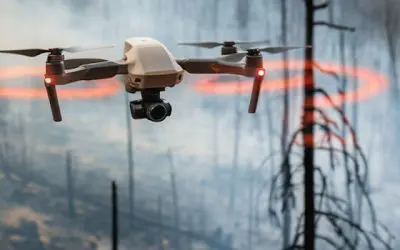The history of fire management in forestry is both extensive and transformative. Early indigenous communities practiced controlled burns to manage land, improve hunting grounds, and reduce wildfire risks. However, it wasn’t until the late 19th and early 20th centuries that structured fire management strategies emerged in response to catastrophic wildfires. One pivotal moment was the Great Fire of 1910, which ravaged over 3 million acres in the U.S., catalyzing the establishment of the U.S. Forest Service’s fire suppression policies. This marked the beginning of organized fire management, emphasizing total fire exclusion—a practice that we now know can lead to the buildup of fuel loads, ironically making forests more prone to severe fires. (Forest History Society)
Today, we’ve come full circle, with a growing appreciation for the role of fire as a natural process within ecosystems. Controlled burns are recognized as essential tools in forest restoration, reducing the risk of catastrophic wildfires and maintaining biodiversity. This historical evolution underscores the importance of adopting adaptive fire management strategies that respond to changing environmental conditions.
The Critical Value of Fire Management
Why does fire management matter? In essence, it’s about safeguarding our forests and their economic, ecological, and social value. Well-managed fire regimes play a crucial role in maintaining healthy ecosystems, promoting regeneration, and reducing invasive species. Moreover, fire management is essential for protecting timber resources, reducing carbon emissions, and ensuring that forest ecosystems continue to provide services such as water regulation, wildlife habitat, and recreation. (U.S. Forest Service Restoration)
From an entrepreneurial perspective, investing in effective fire management means contributing to sustainable forest economics, which is fundamental to preserving the long-term value of our forests. For those interested in the intersection of nature and technology, there are significant opportunities to innovate in this space through data analytics, remote sensing, and predictive modeling.
Current Challenges in Fire Management
The challenges facing fire management today are more complex than ever. Climate change is increasing the frequency, intensity, and duration of wildfires, while human encroachment into wildland-urban interfaces complicates suppression efforts. Additionally, forest management practices of the past have created densely packed forests with high fuel loads, making them more susceptible to severe fires. (Reason Foundation)
These challenges present a pressing need for innovation. Fortunately, digital forestry technologies are emerging as game-changers. For instance, satellite imagery and drones equipped with infrared cameras can monitor vast forested areas in real-time, identifying potential fire risks before they escalate. Additionally, data analytics and machine learning models can forecast fire behavior, enabling proactive management strategies. A prime example is the work done by the Forest Service’s Remote Sensing Applications Center, which uses satellite data to track and predict wildfire patterns.
Lessons Learned from Overcoming Past Challenges
Looking back, several examples highlight how we’ve overcome fire management challenges in the past. Take the 1988 Yellowstone fires, which burned over 1.2 million acres. Initially deemed a disaster, this event led to significant policy shifts, recognizing that fire is a natural and necessary part of forest ecosystems. As a result, more adaptive fire management strategies emerged, incorporating controlled burns to reduce fuel loads and maintain ecological balance.
Another example is the development of remote sensing technology. In the 1970s, the Landsat satellite program provided the first large-scale, real-time data on wildfires, revolutionizing how we monitor and respond to fire events. This innovation laid the groundwork for today’s more advanced ForestTech solutions.
The Future of Fire Management: Embracing Digital Forestry
The future of fire management lies in leveraging technology to create smarter, more effective strategies. Digital forestry tools are at the forefront, offering ways to monitor, predict, and respond to wildfires with unprecedented accuracy. Startups and entrepreneurs are leading the charge, developing innovative solutions such as AI-driven fire detection systems, drone-based surveillance, and advanced simulation models that can predict fire spread under different weather conditions.
Moreover, ForestTech is unlocking new avenues for investment. The integration of digital tools in fire management not only enhances our ability to protect forests but also presents lucrative opportunities for those willing to support startups in this space. As forest restoration and forest economics continue to evolve, the potential for technology-driven growth is immense.
For instance, companies like SilviaTerra are using machine learning to analyze satellite data and create detailed forest inventories, enabling more effective fire management strategies. Such innovations not only contribute to fire management but also play a vital role in broader forest restoration efforts.
Key Takeaways
- Fire management has evolved from strict suppression policies to recognizing fire’s role in maintaining healthy ecosystems.
- Digital forestry technologies offer innovative solutions for addressing current fire management challenges.
- There is significant potential for startups and investors to contribute to the advancement of ForestTech in fire management.
Call to Action
Are you an entrepreneur or investor ready to make an impact in the forestry industry? Join our mission at Talking Tree Ventures and connect with a community dedicated to advancing ForestTech. Sign up for our newsletter, share your insights in the comments, and let’s work together to create a sustainable future.
- Why Forestry Innovation is a Big Opportunity
- Forest Restoration: Balancing Technology, Sustainability, and Economic Growth
- 7 Insights into Forest Economics for Entrepreneurs and Investors
- Fire Management in Forestry: History, Challenges, and Future Trends





0 Comments